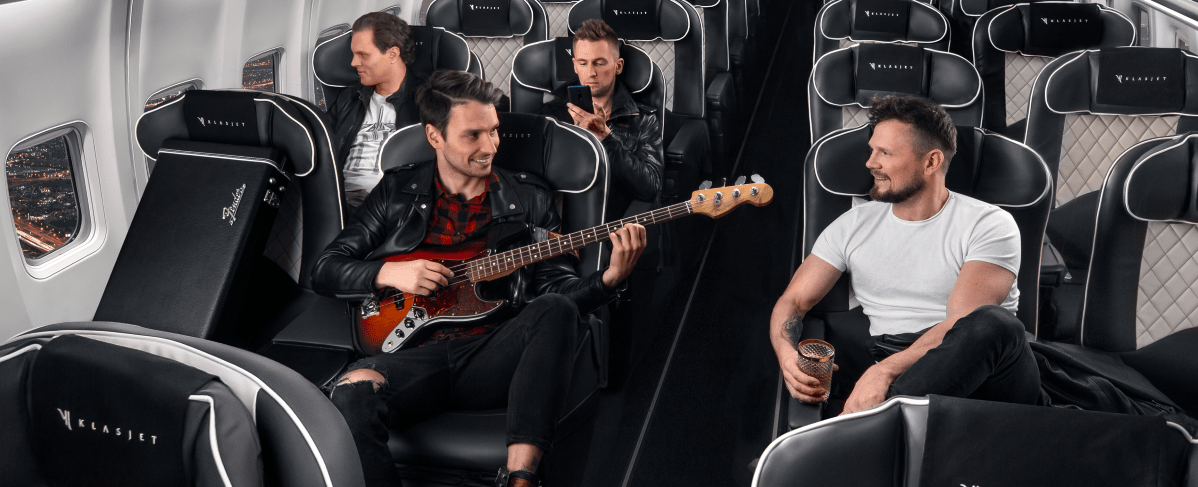Have you ever wondered how the biggest names in the entertainment industry travel? Actors, musicians, producers, film directors, you name it – the nature of their work makes flying pretty much mandatory. And far from everyone can afford their own private jet. So how do they get around? To get a peek behind the curtain of arranging charter flights for show biz megastars and headliners, we booked some time with Lukas Petrauskas, CCO at KlasJet, who gave us a fairly comprehensive overview that we present for your reading pleasure below.
As Lukas told us, everything begins with making an offer, which takes a good deal of thoroughness and very exact scheduling. This is even more important for KlasJet, as the company is mostly providing tours around Europe, which take anywhere between a week and 1.5 months from start to finish.
“The next step consists of negotiations over the contract. In our experience, this is a fairly protracted process, headed by the lawyers of both parties, which can take up to 3 months. Given that our clients in this case are some of the world’s most famous people, their representatives are extremely particular as to how the contract is formulated – hence the long deliberations,” Lukas said.
One of the most common preferences, or in some cases – demands, is to have the same aircraft and crew during the entire trip. In most cases, this can be complied with directly, but sometimes compromises are unavoidable. For instance, the flight crew may have already been assigned to a different project; there’s also illness and other unforeseen complications.
Some clients also demand strict confidentiality and require the airline to provide access to FBO, GAT, or VIP terminals. While this, as such, isn’t a hard condition to comply with, not all airports have the capacity to admit larger groups of people through such terminals – and our tours are specifically designed for such groups.
He also pointed out that finding additional services – fast track and porter services, tarmac access, and other – and then arranging for them to be provided to the client is often exceedingly demanding in terms of time and effort. The key issue in this regard is finding and implementing a solution that’s not only acceptable to the client, but also operationally viable to the airline.
When it comes to catering, Lukas explained, clients falling under this category aren’t especially particular, but a certain (rather high) level of quality must be assured. In other words, airlines can’t just pick the first provider that comes to mind, but have to do quite a bit of research and careful verification. “Here’s a curious stat for you – during the last flight, roughly 80% of clients ask for alcoholic beverages to celebrate the end of the tour. Whereas prior to it, serving drinks is normally prohibited,” Lukas shared.
As mentioned above, charter tours for people from the entertainment industry happen during high season, which means that implementing the meticulously drawn-up tour plan is no easier than putting it together in the first place. For instance, just because a provider has committed to deliver on a specific time doesn’t mean it will actually happen. As Lukas said:
“This is to be expected, at least to some degree. It’s high season, after all, which means that everyone’s running around with their hair on fire, struggling to get things done on time. For us, this means a lot of double- and triple-checking prior to each flight. In many cases, we even agree with the client to have a representative from our office physically present during preparations at each airport. This is actually an excellent way to make sure things run smoothly and without delay”.
In the end, Lukas emphasised that charter tour flights, just like regular passenger trips, must be timely – and this requires the full dedication of the crew. Last year, in order to maximise operational efficiency, KlasJet had established a Part-145 maintenance department, which gave a substantial boost in the right direction. Part-145 is a regulatory framework outlined by the European Aviation Safety Agency (EASA) that sets the procedure for aircraft maintenance practices to ensure they meet the required safety and quality standards.
“The new department, working in tandem with the Maintenance Control Centre (MCC), ensures that we have a flying spanner – an engineer onboard, during every flight, and provides very useful assistance with operational implementation when it comes to supporting aircraft servicing and technical maintenance,” Lukas explained.

